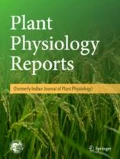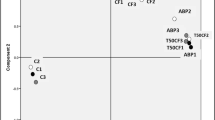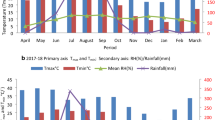Abstract
The uses of environment friendly biological fertilizers to improve plant growth and crop productivity are of great importance for soil health and sustainable agriculture. Hence, an experiment was conducted in two successive rabi seasons of 2017–18 and 2018–19 to analyze the impact of microbial consortium (combination of local strains of Azotobacter, phosphorus solubilizing bacteria, potassium mobilizing bacteria and zinc solubilizing bacteria) and inorganic fertilizers on growth, yield and economics of wheat. The experiment consisting twelve treatment combinations and different levels of inorganic fertilizers along with biofertilizer consortia replicated three times in randomized block design. The results emanated from present investigation revealed that plant height, plant biomass, root length, chlorophyll content in leaves at different growth stages of wheat crop was influenced by biofertilizer + RDF treatment combinations. The maximum yield attributes viz. effective tillers (85.67 m row length), ear length (16.46 and 11.10 cm with awns and without awns, respectively), test weight (57.12 g), number of spikelet ear−1 (86.67) were obtained under biofertilizer consortia 2 with 100% RDF which was statistically higher over control. This increasing trend in yield attributes resulted higher grain (54.83 q ha−1), straw (79.26 q ha−1), biological yield (134.09 q ha−1) and harvest index (40.92%) in superior treatment combination i.e. biofertilizer consortia 2 with 100% RDF, ultimately obtained the utmost monetary return in terms of net return (Rs 97,893 ha−1) and B–C ratio (2.66).
Similar content being viewed by others
Abbreviations
- RDF:
-
Recommended dose of fertilizers
- NPK:
-
Nitrogen phosphorus potassium
- PSB:
-
Phosphate solubilizing bacteria
- KMB:
-
Potassium mobilizing bacteria
- ZSB:
-
Zinc solubilizing bacteria
References
Ardakani, M. R., Mazaheri, D., Mafakheri, S., & Moghaddam, A. (2011). Absorption efficiency of NPK through triple inoculation of wheat (Triticum aestivum L.) by Azospirillum brasilense, Streptomyces spp., Glomus intaradices and manure application. Physiology and Molecular Biology of Plants, 17, 181–192.
Ashraf, A., Ristina, S. S., Asad, M., Hasan, M., Qamar, H., Mudassar, M., Raza, M., Anum, W., Abbasi, W., & Arshad, A. (2019). Variability and correlation study of different newly developed sunflower hybrids in Pakistan. International Journal of Bioscience, 14, 398–408.
Bradáčová, K., Kandeler, E., Berger, N., Ludewig, U., & Neumann, G. (2020). Microbial consortia inoculants stimulate early growth of maize depending on nitrogen and phosphorus supply. Plant, Soil and Environment, 66, 105–112.
Chander, S. (2012). Speciality fertilizers in Indian agriculture, issues and strategies. Indian Journal of Fertilizer, 8, 10–11.
Chandna, P., Khurana, M. L., Ladha, J. K., Punia, M., Mehla, R. S., & Gupta, R. (2011). Spatial and seasonal distribution of nitrate-N in groundwater beneath the rice-wheat cropping system of India: A geospatial analysis. Environmental Monitoring and Assessment, 178, 545–562.
Cui, F., Yan, G., Zhou, Z., Zheng, X., & Deng, J. (2012). Annual emission of nitrous oxide and nitric oxide from a wheat- maize cropping system on a silt loam calcareous soil in the North China plain. Soil Biology & Biochemistry, 48, 10–19.
Dahiya, S., Jaiwal, P., & Singh, R. P. (2004). Efficient nitrogen assimilation and high productivity in rice (Oryza sativa L.) applied with organic matrix based slow release nitrogen fertilizers. Physiology and Molecular Biology of Plants, 10, 83–92.
Dai, J., Bean, B., Brown, B., Bruening, W., Edwards, J., Flowers, M., Karow, R., Lee, C., Morgan, G., Ottman, M., Ransom, J., & Wiersma, J. (2016). Harvest index and straw yield of five classes of wheat. Biomass and Bioenergy, 85, 223–227.
Eldakak, M., Ahmed, M., Asif, M., Milad, S. I. M., Nawar, A. I., Aslam, Z., Goyal, A., Rohila, J. S. (2014) Drought resistance in small grain cereal crops. In M. Pessarakli (Ed.), Handbook of plant and crop physiology (3rd edn, p. 1031) CRC Press, Taylor & Francis Group.
Emilsson, T., Berndtsson, J. C., Mattsson, J. E., & Rolf, K. (2007). Effect of using conventional and controlled release fertilizer on nutrient run off from various vegetated roof systems. Ecological Engineering, 2, 260–271.
Gogoi, B., & Baruah, K. K. (2012). Nitrous oxide emission from fields with different wheat and rice varieties. Pedosphere, 22, 112–121.
Gulnaz, S., Sajjad, M., Khaliq, I., Khan, A. S., & Khan, S. H. (2011). Relationship among coleoptile length, plant height and tillering capacity for developing improved wheat varieties. International Journal of Agriculture and Biology, 13, 130–133.
Inskeep, W. P., & Bloom, P. R. (1985). Extinction coefficients of chlorophyll a and B in n, n-dimethylformamide and 80 % acetone. Plant Physiology, 77, 483–485.
Jackson, M. L. (1973). Soil chemical analyses. Prentice Hall.
Kumar, M., Bauddh, K., Sainger, M., Sainger, P. A., Singh, J. S., & Singh, R. P. (2012). Increase in growth, productivity and nutritional status of rice (Oryza sativa L. cv Bastmati) and enrichment in soil fertility applied with an organic matrix entrapped urea. Journal of Crop Science Biotechnology, 15, 137–144.
Kumar, S., Bauddh, K., Barman, S. C., & Singh, R. P. (2014). Organic matrix entrapped bio-fertilizers increase growth, productivity and yield of Triticum aestivum L. and mobilization of NO3-, NO2-, NH4+ and PO43- from soil to plant leaves. Journal of Agricultural Science and Technology, 16, 315–329.
Lindsay, W. L., & Norvell, W. A. (1978). Development of a DTPA soil test for zinc, iron, manganese and copper. Soil Science Society of America Journal, 42, 421–428.
Lupwayi, Z. N., Grant, C. A., Soon, Y. K., Clayton, G. W., Bittman, S., Malhi, S. S., & Zebarth, B. J. (2010). Soil microbial community response to controlled release urea fertilizer under zero tillage and conventional tillage. Applied Soil Ecology, 45, 254–261.
Niu, J., Zhang, W., Ru, S., Chen, X., Xiao, K., Zhang, X., Assaraf, M., Imas, P., Magen, H., & Zhang, F. (2013). Effects of potassium fertilization on winter wheat under different production practices in the North China Plain. Field Crops Res, 140, 69–76.
Olsen, S. R., Cole, C. H., Wantanabe, F. S., & Dean, L. A. (1954). Estimation of available phosphorus by extraction with sodium bicarbonate. U.S. Dept. of Agric. Circ. 939, Washington, DC
Ozlu, E., & Kumar, S. (2018). Response of soil organic carbon, pH, electrical conductivity, and water stable aggregates to long-term annual manure and inorganic fertilizer. Soil Science Society of America Journal, 82, 1243–1251.
Rawat, S. K., Singh, R. K., & Singh, R. P. (2010). Seasonal variation of nitrate level in ground and surface waters of Lucknow and its remediation using certain aquatic macrophytes. International Journal of Lakes and Rivers, 3, 25–35.
Rawat, S. K., Singh, R. K., & Singh, R. P. (2012). Remediation of nitrite in ground and surface waters using aquatic macrophytes. Journal of Environmental Biology, 33, 51–56.
Sharma, P., Singh, G., & Singh, R. P. (2012). Conservation tillage and optimal water supply enhanced microbial enzymes (glucosidase, urease and phosphatase) activities in field under wheat cultivation during various nitrogen management practices. Archives of Agronomy and Soil Science, 59, 911–928.
Sharma, P., Singh, R. K., & Singh, R. P. (2011). Conservation tillage, optimal water and organic nutrient supply enhanced soil microbial activities during wheat (Triticum aestivum L.) cultivation. Brazilian Journal of Microbiology, 42, 531–542.
Sharma, V. K., & Singh, R. P. (2011). Organic matrix based slow release fertilizers enhances plant growth, nitrate assimilation and seed yield of Indian mustard (Brassica juncia L.). Journal of Environmental Biology, 32, 619–624.
Shewry, P. R., & Hey, S. J. (2015). The contribution of wheat to human diet and health. Food Energy Security, 4, 178–202.
Singh, C. M., Sharma, P. K., Kishor, P., Mishra, P. K., Singh, A. P., Verma, R., & Raha, P. (2011). Impact of integrated nutrient management on growth, yield and nutrient uptake by wheat (Triticum aestivum L.). Asian Journal of Agricultural Research, 5, 76–82.
Singh, R. P., Kumar, M., & Jaiwal, P. K. (2008a). Improvement in nitrogen use efficiency and yield of crop plants by sustained nutrient supply and enhanced nitrogen assimilation. In B. Bose & A. Hemantranjan (Eds.), Development in physiology, biochemistry and molecular biology of plants (pp. 1–31). New India Publishing Agency.
Singh, R. P., Sainger, M., Bauddh, K., Sengar, R. S., & Jaiwal, P. K. (2010). Sustained nutrient supply reduced nutrient loss and high plant productivity with slow release fertilizers. In R. S. Sengar, A. K. Sharma (Eds.), Stable food production and sustainable agriculture; a challenge ahead 21st century (pp. 62–79). Studium Press (India) Pvt Ltd.
Singh, R. P., Sengar, M., Singh, D. P., & Jaiwal, P. K. (2008b). Nitrate and ammonia transporters. In P. K. Jaiwal, R. P. Singh, O. P. Dhankher (Eds.), Membrane and vacuolar transporters in plants (pp. 345–371). CAB International.
Sleper, D. A., & Poehlman, J. M. (2006). Breeding field crops (pp. 290–308). Blackwell publishing.
Subbiah, B. V., & Asija, G. L. (1956). A rapid procedure for estimation of available nitrogen in soil. Current Science, 25, 259–260.
Sureshkumar, A. P., Patel, K. S., Asodiya, P. S., & Parmar, V. K. (2014). Input use, costs structure, return and resource use efficiency analysis of wheat crop in South Gujarat, India. International Journal of Agricultural Extension, 2, 5–12.
Titah, H. S., Abdullah, S. R. S., Mushrifah, I., Anuar, N., Basri, H., & Mukhlisin, M. (2013). Effect of applying rhizo-bacteria and fertilizer on the growth of Ludwigia octovalvis for arsenic uptake and accumulation in phytoremediation. Ecology and Engineering, 58, 303–313.
Tsonev, T., & Lidon, F. J. C. (2012). Zinc in plants – an overview. Emirates Journal of Food and Agriculture, 24, 322–333.
Walkley, A., & Black, I. A. (1934). An examination of the Degtijareff method for determining soil, organic matter and proposed modification of the chromic acid titration method. Soil Science, 34, 29–38.
Wang, Q., Li, F., Zhao, L., Zhang, E., Shi, S., Zhao, W., Song, W., & Vance, M. M. (2010). Effects of irrigation and nitrogen application rates on nitrate nitrogen distribution and fertilizer nitrogen loss, wheat yield and nitrogen uptake on a recently reclaimed sandy farm land. Plant and Soil, 337, 325–339.
Weligama, C., Sale, P. W. G., Conyers, M. K., Liu, D. L., & Tang, C. (2010). Nitrate leaching stimulates subsurface root growth of wheat and increase rhizosphere alkalization in a highly acidic soil. Plant and Soil, 328, 132.
Zai, A. K. E., Horiuchi, T., & Matsui, T. (2008). Effects of compost and green manure of pea and their combinations with chicken manure and rapeseed oil residue on soil fertility and nutrient uptake in wheat-rice cropping system. African Journal of Agricultural Research, 3, 639–663.
Zhang, J., Han, W., Huang, L., Zhang, Z., Ma, Y., & Hu, Y. (2016). Leaf chlorophyll content estimation of winter wheat based on visible and near-infrared sensors. Sensors, 437, 1–10.
Acknowledgements
The financial assistance from All India Network Project on soil biodiversity and biofertilizers and Rastriya Krishi Vikas Yojana (RKVY) and AICRP on Wheat research project are highly acknowledged.
Author information
Authors and Affiliations
Contributions
DJ and SKS conceived and designed the experiments; SC, AAB, SKK and RHM performed experiments; DJ, JC and SRM wrote the manuscript. All authors read and approved the final manuscript.
Corresponding author
Ethics declarations
Conflict of interest
The authors declare that they have no conflict of interest.
Additional information
Publisher's Note
Springer Nature remains neutral with regard to jurisdictional claims in published maps and institutional affiliations.
Rights and permissions
About this article
Cite this article
Jain, D., Meena, R.H., Choudhary, J. et al. Effect of microbial consortia on growth and yield of wheat under typic haplustepts. Plant Physiol. Rep. 26, 570–580 (2021). https://doi.org/10.1007/s40502-021-00607-y
Received:
Accepted:
Published:
Issue Date:
DOI: https://doi.org/10.1007/s40502-021-00607-y




